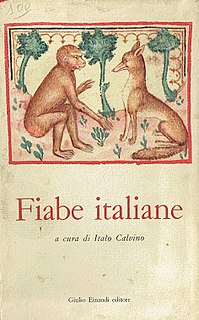Fair Brow is an Italian fairy tale collected by Thomas Frederick Crane in his Italian Popular Tales. [1]
Italo Calvino included a variant from Istria in his Italian Folktales . He noted that the grateful dead man was a common medieval motif. [2]
A merchant sent his son off to make money. Once he spent it all paying off a dead man's debts, so he could be buried, and another time, he bought a slave woman, the Sultan's kidnapped daughter, and married her. His father beat them both and drove them out of his home. The wife said that she would paint, and her husband would sell the paintings, though he must not tell where they came from. Turks saw them, recognized the work, and told him they wanted more. He said to come to his house, where his wife painted them, and they seized her and carried her off.
He walked on the shore, and an old man agreed to have him fish with him. They were captured by Turks and sold to the Sultan as slaves. The old man was made a gardener, and the young man to carry bouquets to the Sultan's daughter, whom the Sultan had imprisoned in a tower as punishment. One day his wife recognized him while he was singing. They escaped with a great deal of treasure.
The old man said that they must divide the treasure. The young man offered him half. When the old man asked if his wife was also half his, the young man offered him three quarters. The old man told him that he was the dead man whose debts he had paid, and vanished. The young man was reconciled with his father, who died not long after, leaving him all his wealth.

Italo Calvino was an Italian writer and journalist. His best known works include the Our Ancestors trilogy (1952–1959), the Cosmicomics collection of short stories (1965), and the novels Invisible Cities (1972) and If on a winter's night a traveler (1979).

Italian Folktales is a collection of 200 Italian folktales published in 1956 by Italo Calvino. Calvino began the project in 1954, influenced by Vladimir Propp's Morphology of the Folktale; his intention was to emulate the Straparola in producing a popular collection of Italian fairy tales for the general reader. He did not compile tales from listeners, but made extensive use of the existing work of folklorists; he noted the source of each individual tale, but warned that was merely the version he used.

The Frog Princess is a fairy tale that has multiple versions with various origins. It is classified as type 402, the animal bride, in the Aarne–Thompson index. Another tale of this type is Doll i' the Grass.
The Canary Prince is an Italian fairy tale, the 18th tale in Italian Folktales by Italo Calvino. He took the tale from Turin, making various stylistic changes; he noted it developed a medieval motif, but such tales as Marie de France's Yonec produced a rather different effect, being tales of adultery. A variant on Rapunzel, Aarne–Thompson type 310, The Maiden in the Tower, it includes many motifs that differentiate it from that tale. Other fairy tales of this type include Anthousa, Xanthousa, Chrisomalousa, Petrosinella, Prunella, and Rapunzel.

"The Three Spinners" is a German fairy tale collected by the Brothers Grimm in Grimm's Fairy Tales. It is Aarne–Thompson type 501, which is widespread throughout Europe.

"Bearskin" is a fairy tale collected by the Brothers Grimm. A variant from Sicily, "Don Giovanni de la Fortuna", was collected by Laura Gonzenbach in Sicilianische Märchen and included by Andrew Lang in The Pink Fairy Book. Italo Calvino included another Italian version, "The Devil's Breeches" from Bologna, in his Italian Folktales.
The Fair Fiorita is an Italian fairy tale collected by Thomas Frederick Crane in Italian Popular Tales. Italo Calvino included a variant of it, The Princesses Wed to the First Passer-By, in his Italian Folktales.
How the Devil Married Three Sisters is an Italian fairy tale found in Thomas Frederick Crane's Italian Popular Tales (1885). It was collected and originally published in German as "Der Teufel heirathet drei Schwestern" by Widter and Wolf in 1866.
"The Slave Mother" is an Italian fairy tale, collected by Italo Calvino in Italian Folktales, from Terra d'Ortano.
Misfortune is an Italian fairy tale, from Palermo, collected by Italo Calvino in his Italian Folktales. Another telling of the tale appears under the title Unfortunate in A Book of Enchantments and Curses, by Ruth Manning-Sanders.
"Bella Venezia" is an Italian fairy tale collected by Italo Calvino in his Italian Folktales. Calvino selected this variant, where the heroine meets robbers, rather than others that contain dwarfs, because he believed the dwarfs were probably an importation from Germany. It is Aarne-Thompson type 709, Snow White. Others of this type include Gold-Tree and Silver-Tree, Nourie Hadig, La petite Toute-Belle, and Myrsina.
Princess Rosette is a French literary fairy tale written by Madame d'Aulnoy. Andrew Lang included it in The Red Fairy Book.
"The Pig King" or "King Pig" is an Italian literary fairy tale written by Giovanni Francesco Straparola in his The Facetious Nights of Straparola. Madame d'Aulnoy wrote a French, also literary, variant, titled Prince Marcassin.
The King who would have a Beautiful Wife or The King Who Wanted a Beautiful Wife is an Italian fairy tale collected by Laura Gonzenbach in Sicilianische Märchen. Thomas Crane included in his Italian Popular Tales, and Andrew Lang, in The Pink Fairy Book.
"The Little Girl Sold with the Pears" is an Italian fairy tale published by Italo Calvino in Italian Folktales, from Piedmont. Ruth Manning-Sanders included a variant, as "The Girl in the Basket", in A Book of Ogres and Trolls.
Pintosmalto or Pinto Smauto is an Italian literary fairy tale written by Giambattista Basile in his 1634 work, the Pentamerone.
Biancabella and the Snake is an Italian literary fairy tale written by Giovanni Francesco Straparola in The Facetious Nights of Straparola.
Sapia Liccarda is an Italian literary fairy tale written by Giambattista Basile in his 1634 work, the Pentamerone. It is not known whether he had a specific source, either literary or oral, for this tale.
The King of Love is an Italian fairy tale from Sicily collected by Giuseppe Pitre and translated into English by Thomas Frederick Crane in Italian Popular Tales.
Grateful dead is both a motif and a group of related folktales present in many cultures throughout the world.